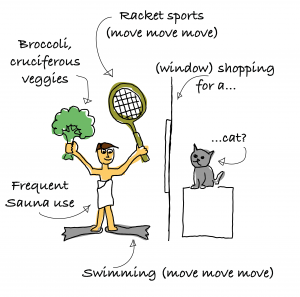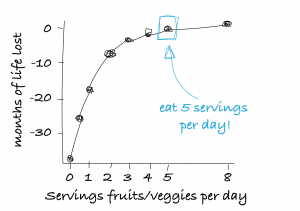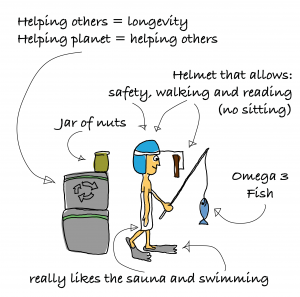Good morning, Matt. Digital birds are chirping as a soft alarm-clock light fills the room. You are waking up to the start of a new day, on the lovely road of longevity.
07h00: Rise and shine!
You leap out of bed to greet the day. You love those birdies Matt, no one is pushing you but yourself out of bed this morning. You know that just having a sense of purpose and meaning in life is already good for your lifespan1.
07h30: Breakfast
You forget about the frosty puffed-corn-wheat flakes and instead you go for longevity food: fiber. Could be rolled-oats, could be fruits, could be whole-grain bread. One study following over 1,600 Australians who were disease-free at the start of the study, found that 10 years later, fiber was the most important factor in the diet to account for the healthy aging (only 15% continued to be disease-free in that time)2. So you go for the fiber. It’s anyways great for your gut microbiome.

08h30: Getting to work
You are out the front door and are now debating on how to get there. Cycling to work might be the best way, especially if you are a woman in China. Over a 5 year period, cycling as a means of transportation was found to reduce mortality in a study looking at over 67,000 Chinese women3. Cycling seems good for the Finnish too, where it was found to reduce cardiovascular related mortality, especially for women, in a study following over 26,000 people for almost 20 years4.
This morning though you are running late: you need the car. So you jump in but at least you do the obvious and buckle up, and do your best to minimize your commute time. Time spent commuting in the car was found to be inversely related to cardiorespiratory fitness, and directly related to body mass index, waist circumference, and systolic and diastolic blood pressure, in one study following over 4,000 Texan adults5. Those are all pretty important to keep in check for the long road to 120. OK. So to compensate for the drive, you park in the back of the parking lot, and walk the rest of the way. Just walking has lots of associations with longevity6–8.
09h00: Working it
A short commute and walk later, you get to work. ..but where do you work Matt? You have heard that many studies found that the job, education level, and income you have are all related to how long you’ll live (9–12 and see here, here, and especially here).
One study looking at the income history of millions of Americans who died between 2001 and 2014 found that the life expectancy gap existing between the richest 1% and poorest 1% of the population was over 14 years for men (!) and just over 10 years for women (!)9. That sounds like something to worry about!
But you aren’t worried. Your income doesn’t necessarily have to correlate with your life expectancy, as long as you are engaged with your health9. Lucky Matt, because you don’t earn much. Just say it: you’re a data analyst for a small startup. Even though you make very long hours and could earn twice the salary at a big firm, you love your freedom.
10h00: Really working it
What you are worried about is how much you are sitting. There is a famous 1953 study that showed that workers of the London Transport system that had less physical activity during work (drivers that were mainly sitting) had higher rates of heart disease than did their fellow colleagues who were more active (i.e. conductors, ticket checkers that walked around)13. That study was just the start. Another study conducted in over 123,000 men and women found that those sitting for longer periods in the day (6 or more hours) compared to those sitting shorter periods (less than 3 hours) had higher all-cause mortality in the 14 year study period14.
It’s scaring you even more when you consider the meta analysis which looked at almost 70,000 cancer cases documented in 43 studies. It found an increased chance of certain types of cancers associated to sedentary behavior at work: compared to those spending the lowest amount of sedentary time at work, those with the highest sedentary time had a 24% increased risk of colon cancer and a 32% increased risk of endometrial cancer15.
How to combat this in your typical day as you live to 120? In a healthier-than-average group of people (British civil servants who were engaging in moderate to vigorous activity about 12 hours per week and walking on average about 40 minutes per day), no association between sitting time and all-cause mortality was observed16. However, another study, a meta analysis taking into account 47 studies, showed that sitting is bad for you, even if you are trying to exercise it all away later. ‘Sitting time’ was linked to cardiovascular related mortality, cancer related mortality, and ‘all-cause’ mortality, regardless of other exercise17.
Activity and movement is so important that specific recommendations have been established for movement at work, at least in the UK: If you are indeed working predominantly at your desk, you should start off trying to get 2 hours per day of standing or light walking time, and progress to a recommended 4 hours per day of standing or light walking18. Periodically switching between a sit-stand desk and regularly breaking up your sitting times with walks are the way to go.
Time to get up off your butt Matt. Maybe you go get a coffee, maybe you have to go to the bathroom, or maybe you just need to go ask a colleague something. Well lucky for you, it’s lunchtime, so you go round up the coworkers and march over to the lunchroom.
12h00: Lunchtime
So what’s for lunch? Whatever it is, it is going to involve fruits and vegetables. Eating 5 servings of fruits and vegetables a day is often recommended, and one study with 13 years of follow up, looking at over 71,000 Swedish men and women aged 45–83 years old, found that completely ignoring those recommendations could reduce your life expectancy by 3 years, in a dose-dependent manner19.

And if the ‘mortality’ (i.e. when you die) of the matter doesn’t do it for you (you’re thinking hey, 3 years isn’t that impressive), then the morbidity (i.e. how sick you are with age) should convince you. Vegetarians (and sometimes those with variations on the theme, such as fish eating vegetarians) have been shown to have lower rates of cataracts20, heart disease21, type II diabetes22, certain types of cancers23, and more (or, ‘less’..)24.
So you eat a tasty home made spinach-tomato-avocado-fish-chickpea-apple salad for lunch. Mmmm.
Now back to work.
15h00: Snack time
You were getting your job juices flowing but now you are hungry again, somehow that salad just didn’t hold you over. What to snack on? As an informed consumer you know that the sugar industry tricked us all with research that downplayed the role of sugar in heart disease25, so you don’t grab that candy bar or donut sitting on the coffee table, and instead grab a handful of nuts. Yes, a meta analysis looking at 20 different studies found that eating nuts, at least 20 grams a day, could reduce the risks of cardiovascular disease, total cancer incidents, all-cause mortality, and mortality from diabetes, respiratory diseases, and infections26.
Chomping on those walnuts (or almonds, hazelnuts, cashews, pistachios, pecans, peanuts, or brazil nuts) you are on track to being healthy past 100.
16h00: time to think about the planet
Yes, this time it’s not about you Matt, but about the planet. Even though you are on a path to make yourself live long and healthy, you realize you are not the center of the world. The Earth, is the center of the world. And you know what, thinking about more than yourself could do you some good; for example, volunteering for the benefit of others was found to be associated to reduced mortality in the elderly27.
Anyways, you are in it for the long run, so it is simply logical to keep the earth around for the long run too. The good news is that you are already doing a part for the planet just by being healthy: you are reducing health care costs to your society, you have been reducing car pollution hopefully by walking and cycling, and have been contributing to both carbon emission reduction and a more sustainable world-food supply by eating more plants than animals. But that is just not enough. So you also ask your work to install a BinBang, to help you recycle your waste (OK, sorry Matt, that was too easy of a plug for that cool eco-minded game-changing waste-recycling bin. What, is the founder my girlfriend or something?). Anyways, Let’s move on.
18h00: Sport time
Getting home, you are faced with a timeless problem: do you clean up the house, or go out and play? Don’t worry; science has your back here. While two studies found that housework was associated to lower rates of mortality28,29, one study found that playing sports, but not doing housework, specifically, was associated to lower mortality30. So you go with that one, leave the house messy, and run out the front door ready for sports.
What sport will you play Matt? Another study, looking at 6 different sports in over 80,000 people from Scotland and England, found that a reduction in all-cause mortality was associated to cycling, swimming, racquet sports, and aerobics (but not to running or playing football)31. So you grab a racquet and head out for the tennis court. One day there might be a study done on the health benefits of extreme ironing, which could solve a lot of your after-work decision making problems.
You got it right, the point here is simple: just move. Is it sounding like a recurring theme on your way to 120? It is. When you get home, you don’t want to just plop down in front of the TV. All those studies looking at sitting around at the office, basically found the same or worse when doing it with the TV. Indeed, worldwide, inactivity is though to account for 9% of premature mortality from non-communicable disease. That includes coronary heart disease, type 2 diabetes, breast cancer, and colon cancer32. And one study found that on average, every hour of TV you watch after the age of 25 can reduce your life expectancy by 22 minutes33!
19h00: Coming home
Finally at home for the rest of the evening Matt? A demographer might wish for you to be with your married partner, since a survival advantage is known to exist for married men and women34. As a man you might even benefit from a younger wife (though this age difference could be bad for a woman)35. The well-intentioned demographer might hope to see you with your children too, since some studies have found associations between having children and lower mortality for the parents36,37.
You don’t have that matt, but you do have a lot of friends and a pet fish. Being socially connected can protect your health38 and predict mortality39. So childless and unmarried, as an engaged member of society having quality relationships with people, you will still be on track to health in aging.
19h30: Dinnertime
You resist the urge to call the delivery service, knowing that cooking at home has been associated to lower mortality rates40. Pulling out your cutting board and cooking utensils, you can consider continuing your vegetarian streak, or might think about having fish in the dish, especially one with omega-3 fatty acids. One study looking at over 2,600 older Americans found that those with higher levels of omega-3s in their blood stream had less chances of dying than those with the lowest levels. This advantage resulted in about 2.2 more years of life41. You might also consider making something Mediterranean style42, and being sure to have a big plump broccoli or cruciferous on the plate43, both of which are things that have been associated to lower mortality rates.
20h30: Keeping busy
It’s past dinner and the day is closing off, but you are not yet going to sit down, that’s bad, remember? You need a hobby Matt. Here is a list of possible hobbies that are positively associated with good health or longevity, so pick one:
- Sauna use (in Finland this was inversely associated with occurrence of dementia and Alzheimer’s in men)44
- Cat ownership (in the US this was associated to decreased death due to myocardial infarction)45
- The Tour de France (Not watching it, but competing in it! Seems that tour-de-France cyclists have a survival advantage over their compatriots. Goodluck)46
- Olympic medal winning (Probably under the same line of reasoning as the cyclist’s health state, winning a medal is associated to longer life than average)47
- Frequent shopping (If high intensity cycling and Olympic medal winning aren’t for you, in Taiwan it seemed that shopping behavior in the elderly predicted survival, where shopping more was better, with men benefiting more from it)48
- Winning an Oscar, contrary to popular belief on the Internet, does not seem to provide a significant survival advantage49
Since you might be past your prime for winning an Olympic medal, and your motive for movie stardom has now been shattered, you consider maybe just going shopping a few times for a cat that likes saunas. Whatever it is Matt, you stay active. Tonight, you end up deciding to build an invention, a helmet that holds your e-reader or book so you can walk a lot while reading. Perfectly healthy.

23h15: Bed time
Time to wrap up your day and get to bed. You are sure to brush your teeth well, where good dental hygiene, among other health benefits, is associated to lower dementia rates50. Your room is dark and slightly cool, which will help with falling asleep to get a good night’s rest. Lying in bed, you go to set the alarm. You know that a large meta analysis of sleeping behavior and mortality risk found that people sleeping fewer hours (commonly less than 7 hours per night and often less than 5 hours per night) had a 12% greater risk of dying, and those sleeping longer hours (commonly more than 8 or 9 hours per night) had a 30% greater risk of dying, compared to those sleeping 7-8 hours51. And you close your eyes… and finally sleep – to dream about finding that perfect sauna-loving cat.
Closing off the longevity day
So that was your typical day on your way to 120. The most important, of course, is not the checklist, but to be happy. Work on that first. Getting all the things above in line, like exercise, food, sleep, and meaningful social contacts, tends all to make us happy anyways. That might be why being happy is itself associated to longevity52. Indeed, having a positive attitude toward life with emotional expression is a common feature of the long lived53,54. So much so, that just having a positive outlook towards aging itself, can help make you live longer55, in addition to having life be a more enjoyable road.
Sweet dreams, and see you tomorrow, and the day after… healthily ever after.
